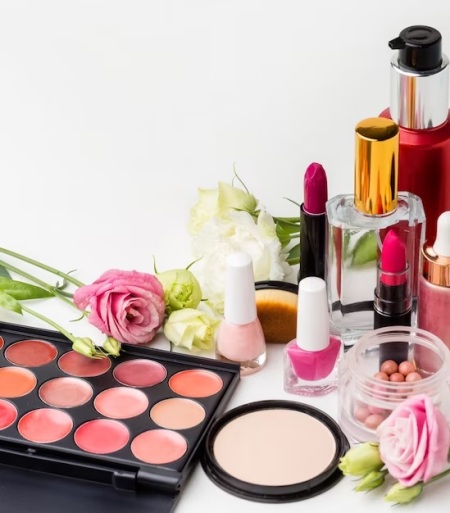
The cosmetics market is a dynamic and ever-evolving industry, set to experience a CAGR of 4.5% during the forecast period of 2024 to 2032. The cosmetics market is driven by the increasing emphasis on skincare, diverse hair care solutions, and the rising demand for makeup. Environmental sustainability remains a restraint, urging the industry to adopt eco-friendly practices. Competitive trends suggest that key players will focus on innovation, sustainability, and global expansion to cater to the evolving beauty preferences and concerns of consumers.

Growing Emphasis on Skin Care
The cosmetics market in 2023 saw substantial growth, driven by the increasing emphasis on skin care products. Consumers are becoming more conscious of their skin health and the importance of preventive skincare measures. Skincare products, including cleansers, moisturizers, serums, and sunscreens, gained significant popularity. This trend is expected to continue, with the highest Compound Annual Growth Rate (CAGR) projected in the skin care product segment during the forecast period from 2024 to 2032. Evidence of this growth can be seen in the rising demand for products with natural and organic ingredients, as consumers seek safer and more effective skincare solutions.
Diverse Hair Care Solutions
In 2023, the cosmetics market experienced substantial growth in the hair care segment. Consumers are looking for diverse hair care solutions to address a wide range of hair-related concerns, from hair loss and dandruff to styling and maintenance. Hair care products such as shampoos, conditioners, treatments, and styling products witnessed increased demand. This trend is expected to continue, with the highest revenue growth and CAGR anticipated in the hair care product segment during the forecast period from 2024 to 2032. The market's response to various hair care needs is evident in the development of specialized and customized products.
Rising Demand for Makeup
The cosmetics market in 2023 was driven by the growing demand for makeup products. Makeup has become an integral part of self-expression and personal grooming for consumers of all genders. Products such as foundations, lipsticks, eyeshadows, and mascaras gained popularity, with consumers experimenting with diverse makeup looks. This trend is expected to continue, with the highest revenue growth and CAGR projected in the makeup product segment during the forecast period from 2024 to 2032. The market's response to changing beauty trends and the introduction of innovative makeup formulations, such as long-lasting and cruelty-free products, is driving its growth.
Restraint in the Cosmetics Market
One significant restraint in the cosmetics market is the increasing concern over the environmental impact of cosmetic products and packaging. Consumers are becoming more conscious of sustainability and are seeking eco-friendly options. The cosmetic industry's reliance on plastic packaging and the disposal of cosmetic waste contribute to environmental issues. Overcoming this restraint requires proactive measures such as the development of sustainable packaging, the reduction of single-use plastics, and the formulation of cosmetics with biodegradable ingredients. Brands that prioritize sustainability and transparency in their practices are likely to gain a competitive edge in the market.
North America to Remain as the Global Leader
From 2024 to 2032, the cosmetics market is expected to experience the highest CAGR in the Asia-Pacific region. This growth is fueled by the rising middle-class population, increased urbanization, and changing beauty standards in countries like China and India. North America is projected to maintain its position as the region with the highest revenue percentage, driven by consumer demand for premium and innovative cosmetic products. Europe is expected to show steady growth, particularly in the skincare and makeup segments, contributing to the market's expansion.
Market Competition to Intensify During the Forecast Period
In 2023, the cosmetics market witnessed intense competition among key players. Companies such as L'Oreal, Procter & Gamble, Estee Lauder, Beiersdorf AG, Clinique Laboratories, LLC, Colgate-Palmolive Company, Galderma Laboratories, L.P., INGLOT SP. Z O.O., and Shiseido Company dominated the market. These industry leaders focused on strategies like product innovation, expanding their product portfolios, and global market expansion through mergers and acquisitions. As we move into the forecast period from 2024 to 2032, it is expected that these players will continue to prioritize sustainability, inclusivity, and digital marketing to meet the evolving demands of consumers. Additionally, they will explore collaborations and partnerships to expand their market reach and adapt to the changing beauty landscape.
Historical & Forecast Period
This study report represents analysis of each segment from 2022 to 2032 considering 2023 as the base year. Compounded Annual Growth Rate (CAGR) for each of the respective segments estimated for the forecast period of 2024 to 2032.
The current report comprises of quantitative market estimations for each micro market for every geographical region and qualitative market analysis such as micro and macro environment analysis, market trends, competitive intelligence, segment analysis, porters five force model, top winning strategies, top investment markets, emerging trends and technological analysis, case studies, strategic conclusions and recommendations and other key market insights.
Research Methodology
The complete research study was conducted in three phases, namely: secondary research, primary research, and expert panel review. key data point that enables the estimation of Cosmetics market are as follows:
Market forecast was performed through proprietary software that analyzes various qualitative and quantitative factors. Growth rate and CAGR were estimated through intensive secondary and primary research. Data triangulation across various data points provides accuracy across various analyzed market segments in the report. Application of both top down and bottom-up approach for validation of market estimation assures logical, methodical and mathematical consistency of the quantitative data.
| ATTRIBUTE | DETAILS |
|---|---|
| Research Period | 2022-2032 |
| Base Year | 2023 |
| Forecast Period | 2024-2032 |
| Historical Year | 2022 |
| Unit | USD Million |
| Segmentation | |
Product
| |
End-User
| |
Distribution Channel
| |
|
Region Segment (2022-2032; US$ Million)
|
Key questions answered in this report